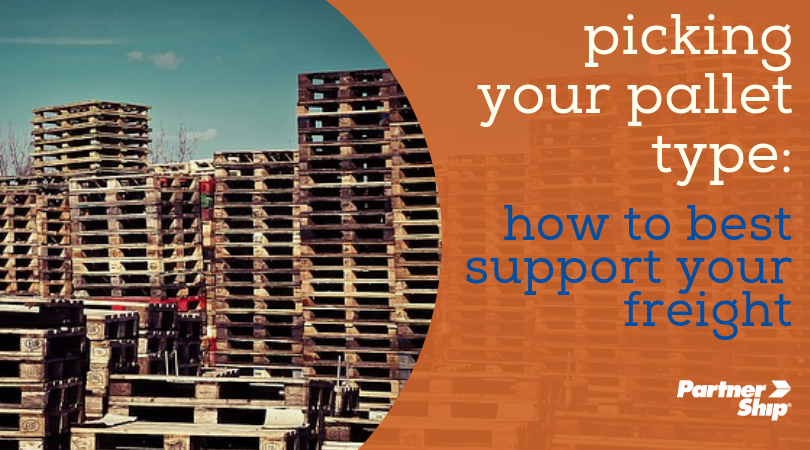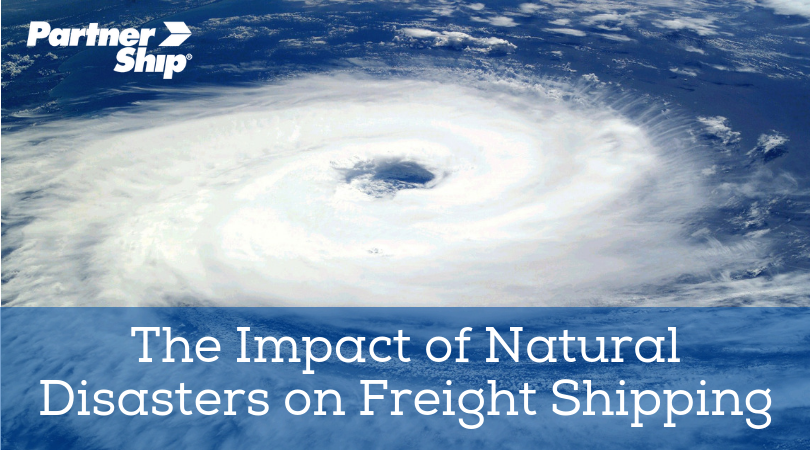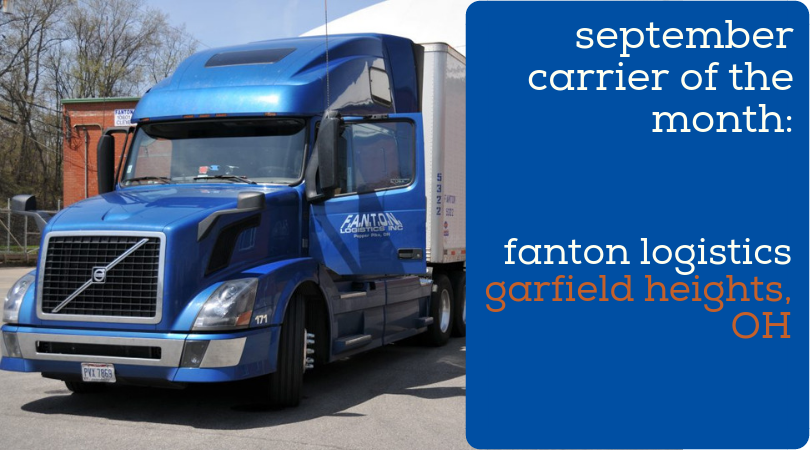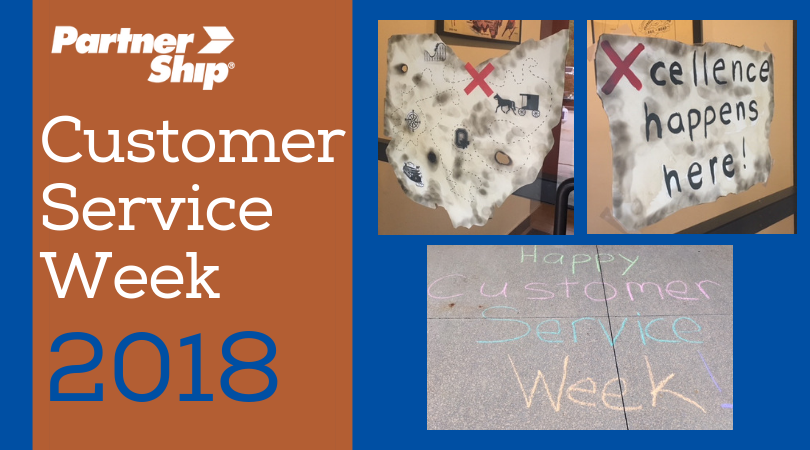October 25, 2018 at 11:55 AM
—
Jen Deming

Not all pallet types are created equal. While it's always smart to properly palletize your freight shipments, construction style and material can vary more than you'd expect. Some structures are better suited for certain types of loads. Before you can understand the best way to organize and stack your freight on a pallet, it's helpful to know the advantages and disadvantages of each type, so that you can better secure your freight and protect yourself against potential damage and loss.
Pallet Structure Types: Stringer vs Block
A stringer pallet is a pallet structure that uses "stringers" (2x4 or 3x4 pieces of board) sandwiched between the top and bottom decks to help support the weight of the load. Sometimes, stringer pallets are notched along the bottom deckboard to allow for partial fork lift entry on all sides. Otherwise, typical construction can limit mobility via forklift.
A
block pallet uses around 4-12 blocks of solid wood or plastic to support the weight of the shipment resting on the top deckboard. Because the pallet construction uses multiple pieces with open spaces at the bottom, there is better allowance for forklift entry on all four sides, allowing for easier lift and mobility.
Now that we've covered the two basic pallet structures, shippers need to understand the differences in construction components so your valuable freight doesn't get damaged. Different industries and commodities require different specifications based on the load. There are 4 primary material groups when it comes to pallet types: wood, plastic, metal, and corrugated paper. Each has its own advantages and disadvantages regarding cost, durability, availability, and sustainability.
Wood Pallets
Wooden or plywood pallets are the most recognizable and commonly used pallet type for a wide variety of industries.
- Advantages: These pallets are the cheapest and also easiest to customize for a commodity's specific needs. They are typically reusable and can hold up in multiple transits. If they are damaged in transit, wooden pallets are very easy to repair. They are easy to stack, and the used wooden materials are popular to re-purpose for mulch, paper, and other project construction.
- Disadvantages: Wooden pallets become fragile after carrying heavier loads and are at risk to weathering, splitting, and splintering. This pallet type can be heavy and therefore more costly to ship. Wood is difficult to clean and porous, growing both bacteria and mold, so food, beverages, and chemicals aren't ideal commodities to ship using this type of pallet.
Plastic Pallets
Notably more expensive than wood, plastic pallets are a great all-around option for those shippers willing to shell out a bit more.
- Advantages: While being the most lightweight of available pallet material options, plastic is still super durable and ideal for heavy loads. The material is easy to clean (safe for transport of food products) and are generally stress, heat, and weather resistant. Plastic pallets are easily recyclable and can be quickly ground down and turned into new pallets. Since they are often made of a single piece with no screws or other hardware, they can be safer to handle than standard wooden pallets.
- Disadvantages: Plastic pallets are pretty inflexible. If they break or crack, it isn't cost efficient to fix, and they have to be melted down and remolded entirely. Because of this, and the effort that goes into making them, they are at a distinctly higher price point than some other pallet types.
Metal Pallets
Strong and resilient, this premium option is one the the least common pallet types, but a very sturdy alternative for certain industries.
- Advantages: Metal (often aluminum) pallets are a great option used for transporting heavy goods because they are the sturdiest and most secure alternative. They are also excellent for businesses moving foodstuffs because of sanitation and safety. They do not break down or rot easily, and are not susceptible to warping or splintering like wood. They are less easily recyclable, but can still be melted down and reused.
- Disadvantages: Up-front initial costs for the purchase of metal pallets is very high. While very durable, these pallets are also extremely heavy, so keep in mind the actual transportation cost may be higher as well.
Corrugated Paper Pallets
As the newest pallet type on the block, this environmentally friendly option is becoming more popular across a variety of industries.
- Advantages: Corrugated paper pallets are lightweight but still strong enough for moderate shipments and typically less expensive than more commonly found wooden pallets. They are completely recyclable and transportation costs are typically lower due to their weight. Because they are intended to be "single use" by nature, they are more sanitary than wooden and plastic pallets.
- Disadvantages: Paper pallets cannot withstand extreme weather conditions, and they are more easily damaged by forklifts and during loading/unloading. Because they are not very reusable, while they are cheap, replacement costs can get pretty high if you are shipping frequently.
While it's pretty common knowledge that you can better protect your freight by palletizing your shipments, it may come as a surprise to many shippers that there are so many different pallet types. Advances in the construction of the basic pallet have greatly improved both durability and cost. Pallet building materials and the engineering of the structure can literally make or break your load. If you would like to learn more about how to best package and palletize your freight, download our free white paper below!
October 15, 2018 at 8:40 AM
—
PartnerShip

Our economy relies on the reliable transportation of goods and materials to link suppliers with manufacturers, manufacturers with retailers, and retailers with consumers. When natural disasters happen, they can negatively impact your carriers, your lanes, your supply chain, and your cost of moving freight.
The natural disasters that have the most profound impact on the movement of freight are floods, hurricanes, blizzards, earthquakes, and ice storms. Each of these natural calamities produces dangerous road conditions that make driving hazardous, and in extreme cases, can wash away roads or make them completely impassable.
Here are 6 ways that natural disasters can impact your freight shipping operations.
Rates. Obviously, your freight shipping rates will increase in a natural catastrophe. If roads become impassable, alternate routes will need to be taken, increasing fuel consumption and lengthening driver on-duty time, both of which are costs that will be passed along to you. Your freight rates will also increase due to tighter capacity with demand outstripping equipment or carriers refusing to travel to areas with impending, or predicted, severe weather. If you do find a driver and / or equipment willing to take the risk, you will pay for it.
Capacity. After a natural disaster, there is substantial competition for limited transportation resources and equipment. This limited capacity will naturally push costs up, but even if you can afford it, the capacity might be impossible to find.
Transit time. If your regular Atlanta to New Jersey lane is two days, it may stretch to three, four, five or more if a hurricane is bearing down on the east coast. The driver may need to wait it out inland until roads are passable, until the warehouse or factory is open again for business, or may just be caught in traffic. This will increase your transit time.
Fuel. Diesel prices always rise in the wake of a natural disaster, especially hurricanes, because refineries are frequently located near where hurricanes make landfall. This can close a refinery or damage it, making fuel more expensive. In 2017, Hurricane Harvey shut down about 17% of US oil refining capacity in Corpus Christi, Port Arthur, Lake Charles and Houston, TX. The disruption to oil refining drives up fuel prices and the fuel surcharges carriers charge you for every load.
Refused loads. Many times carriers will refuse to pick up or deliver freight in the event of a natural disaster. If your carriers refuse your loads, your supply chain will suffer. Your plants can go idle, waiting for materials or components; your customers’ plants can go idle, waiting for you; retailers can run out of inventory; all of which result in opportunity and revenue lost.
Inbound delays. Your flight from Dallas to Los Angeles will be delayed if the inbound flight from Chicago is late due to weather. Inbound freight can be impacted in the same way. Even though your area might not be facing weather issues or a natural catastrophe, if your inbound freight is delayed due to facility shutdowns or power outages caused by severe weather, you will be affected.
Here are some suggestions to deal with the effects of natural disasters on your shipping:
- Two tactics to manage unexpected increases in your freight rates are 1), accrue for contingencies in your annual freight budget and 2), shop around. Working with a broker that has access to thousands of carriers can help you move a load when your regular carriers cannot.
- To alleviate difficulties due to a lack of capacity, think through different transportation options before disaster strikes, such as lining up backup carriers for different regions of the country or shipping lanes, and working with your existing carriers to map out alternate routes.
- Build slack into your supply chain. Just-in-time inventory control is easier when you manage the assets moving your freight but is much more difficult to control when you are relying on carriers which can be delayed to natural disasters.
- Leverage your freight spend. Giving more freight to fewer carriers can help you negotiate lower fuel surcharges.
- Plan your transportation to optimize transportation modes. For example, it might be less expensive to ship your freight as multiple LTL loads rather than full truckload. Or moving everything in one truck might be the better alternative.
Working with a freight broker can help you mitigate the service interruptions, capacity issues and increased costs associated with natural disasters and severe weather. Contact PartnerShip at 800-599-2902 or request a quote to see how we can help you ship smarter so you can stay competitive.
October 12, 2018 at 7:34 AM
—
PartnerShip

The mission of PartnerShip is to help our customers ship smarter and stay competitive. The only way we can do that is to partner with great carriers and we love recognizing our awesome partners!
Our September Carrier of the Month is Fanton Logistics of Garfield Heights, OH. They have been serving customers since 2007 and have a fleet of 23 Volvo power units and 53′ dry vans. Building trust and respect through quality customer service and on-time delivery is their main goal.
The main goal of the PartnerShip Carrier of the Month program is to recognize carriers that do an exceptional job helping customers ship and receive their freight. PartnerShip team members nominate carriers that provide outstanding communication, reliability, and on-time performance.
As our September 2018 Carrier of the Month, Fanton Logistics gets lunch and an official framed certificate to proudly hang on their wall.
Consider becoming a PartnerShip carrier because we try very hard to match our freight carriers’ needs with our available customer loads because we understand that your success depends on your truck being full. If you’re looking for a backhaul load or shipments to fill daily or weekly runs, let us know where your trucks are and we’ll match you with our shippers’ loads. If your wheels aren’t turning, you’re not earning.

October 5, 2018 at 9:00 AM
—
Jen Deming

It's Customer Service Week and the time of year we like to especially celebrate our front line shipping specialists. Day in and out, these guys are making sure PartnerShip is giving the very best experience to every single customer. This year's Customer Service Week theme is "Excellence Happens Here" and it's a team value our reps demonstrate every single day. We played up the idea with a fun pirate spin for this weeks celebrations, because 'x' marks the spot for excellence at PartnerShip. And let's be honest--who doesn't love pirates?
In an effort to celebrate our PartnerShip Customer Service team, we've asked a few of them to share a bit about what inspires them to lead every day and what they've learned since they've joined the team!
What does a "good" customer experience mean to you?
- Helping customers in an efficient and effective manner while maintaining a professional disposition and considering the company's bottom line. -Amanda B.
What is the most important skill to have for a career in customer service?
- Excellent communication. -Andrea
What about customer service appeals to you?
- Working with a lot of different people to help solve issues. -Vince
What is the best way you can help put out a customer service fire?
- Listening, being empathetic and letting the customer know you understand their concerns. Follow up with the customer. -Amanda S.
How do you demonstrate that you are a team player?
- Being there for my co-workers when they ask me for help. I try to offer help when I notice others may need something. -Amanda S.
What's the best customer service experience you've given?
- A customer was leaving a tradeshow and failed to get a quote and shipment scheduled for the move- out. The customer called in a panic because the freight was going to be forced out and they were going to have to pay a very high rate. We were able to walk the customer through completing the material handling form and scheduled/arranged an emergency pick up. The customer was very pleased with the service and thankful for the discounts. -Amanda B.
What are you better at today than you were this time last year?
- Everything! Every day in Customer Service I learn something new about shipping from my management team, customers, and co-workers! -Amanda B.
PartnerShip has a passionate team of Customer Service specialists who are an indispensable resource to both customers and other members of our organization. Though this week is dedicated to recognizing all that they contribute to our business, we know that these guys go beyond expectations every single day to elevate the customer experience and help customers ship smarter. Thank you all!
October 2, 2018 at 7:29 AM
—
PartnerShip

PartnerShip is proud to help celebrate Manufacturing Day 2018.
MFG Day was started in 2012 to acknowledge the large role manufacturing plays in the US economy and to help inspire the next generation of engineers and manufacturers. Its main purpose is to educate and inform students, teachers, and community leaders about how important manufacturing is to their local community and their local economy. PartnerShip is proud to partner with many organizations that support and promote manufacturing, such as NTMA, MAPP, PMPA, Manufacturing Works, and many others!
There is an increasing skilled labor shortage in the manufacturing sector, and MFG Day gives manufacturers an opportunity to open their doors and correct the misperception that manufacturing involves repetitive, unskilled tasks that happen in dark, dirty factories; it’s an opportunity to show people what modern manufacturing really looks like. Manufacturing offers high-quality jobs and career choices. Consider these statistics:
- US manufacturing is the 9th largest economy in the world. (Source: Bureau of Economic Analysis)
- Manufacturing supports 18.5 million jobs in the United States. (Source: Bureau of Labor Statistics)
- Manufacturing comprises nearly 12% of the GDP of the US. (Source: Bureau of Economic Analysis)
- In 2017, the average manufacturing worker in the United States earned $84,832 annually, including pay and benefits. (Source: Bureau of Labor Statistics)
- Over the next decade, nearly 3½ million manufacturing jobs will likely be needed. (Source: Deloitte and the Manufacturing Institute)
Last year, 600,000 people attended MFG Day events, including 267,000 students.
PartnerShip works with hundreds of manufacturers and we’re proud to spread the word about the importance of manufacturing. If you’re a manufacturer that wants to work with a shipping partner that understands your business, contact PartnerShip for a quote on your next shipment!